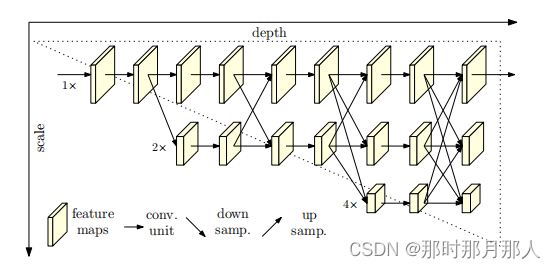论文 Deep High-Resolution Representation Learning for Human Pose Estimation
也是 一个 top-down得对于人体姿态估计得检测方法。和Stack hourglass netword, CPN, MSPN等都大致一样。需要先学习一个人体检测器,将每个人都检测出来,然后在送进单个人体姿态估计模型。
从论文名字可以看出,HIgh-Resolution 高分辨率。
Stack hourglass netword, CPN, MSPN 模型结构都有一定得相似性,类型和Unet结构相似,加上一些残差。都经历一个下采样然后在进行上采样得过程。
然后HRNet 稍微有点不同,保持相同大小进行特征传递。每经过一个Transition是多出一个下采样得分支
如图:

模型得代码如下:
class PoseHighResolutionNet(nn.Module):
def __init__(self, cfg, **kwargs):
pass
def forward(self, x):
# 下面将x缩小了4倍 两个conv得s=2
x = self.conv1(x)
x = self.bn1(x)
x = self.relu(x)
x = self.conv2(x)
x = self.bn2(x)
x = self.relu(x)
x = self.layer1(x)
x_list = []
# 每经过一个transition 产生一个下采样分支
for i in range(self.stage2_cfg['NUM_BRANCHES']):
if self.transition1[i] is not None:
x_list.append(self.transition1[i](x))
else:
x_list.append(x)
y_list = self.stage2(x_list)
x_list = []
# 每经过一个transition 产生一个下采样分支
for i in range(self.stage3_cfg['NUM_BRANCHES']):
if self.transition2[i] is not None:
x_list.append(self.transition2[i](y_list[-1]))
else:
x_list.append(y_list[i])
y_list = self.stage3(x_list)
x_list = []
# 每经过一个transition 产生一个下采样分支
for i in range(self.stage4_cfg['NUM_BRANCHES']):
if self.transition3[i] is not None:
x_list.append(self.transition3[i](y_list[-1]))
else:
x_list.append(y_list[i])
y_list = self.stage4(x_list)
# 最终模型只取 最后一个stage得 第一层得输出来
x = self.final_layer(y_list[0])
return x对于heatmaplabel的生成 和其他网络一样采用 2D高斯函数生成
def generate_target(self, joints, joints_vis):
'''
:param joints: [num_joints, 3]
:param joints_vis: [num_joints, 3]
:return: target, target_weight(1: visible, 0: invisible)
'''
target_weight = np.ones((self.num_joints, 1), dtype=np.float32)
target_weight[:, 0] = joints_vis[:, 0]
assert self.target_type == 'gaussian', \
'Only support gaussian map now!'
if self.target_type == 'gaussian':
target = np.zeros((self.num_joints,
self.heatmap_size[1],
self.heatmap_size[0]),
dtype=np.float32)
tmp_size = self.sigma * 3
for joint_id in range(self.num_joints):
feat_stride = self.image_size / self.heatmap_size
mu_x = int(joints[joint_id][0] / feat_stride[0] + 0.5)
mu_y = int(joints[joint_id][1] / feat_stride[1] + 0.5)
# Check that any part of the gaussian is in-bounds
ul = [int(mu_x - tmp_size), int(mu_y - tmp_size)]
br = [int(mu_x + tmp_size + 1), int(mu_y + tmp_size + 1)]
if ul[0] >= self.heatmap_size[0] or ul[1] >= self.heatmap_size[1] \
or br[0] < 0 or br[1] < 0:
# If not, just return the image as is
target_weight[joint_id] = 0
continue
# # Generate gaussian
# 生成高斯函数进行赋值
size = 2 * tmp_size + 1
x = np.arange(0, size, 1, np.float32)
y = x[:, np.newaxis]
x0 = y0 = size // 2
# The gaussian is not normalized, we want the center value to equal 1
g = np.exp(- ((x - x0) ** 2 + (y - y0) ** 2) / (2 * self.sigma ** 2))
# Usable gaussian range
g_x = max(0, -ul[0]), min(br[0], self.heatmap_size[0]) - ul[0]
g_y = max(0, -ul[1]), min(br[1], self.heatmap_size[1]) - ul[1]
# Image range
img_x = max(0, ul[0]), min(br[0], self.heatmap_size[0])
img_y = max(0, ul[1]), min(br[1], self.heatmap_size[1])
v = target_weight[joint_id]
if v > 0.5:
target[joint_id][img_y[0]:img_y[1], img_x[0]:img_x[1]] = \
g[g_y[0]:g_y[1], g_x[0]:g_x[1]]
if self.use_different_joints_weight:
target_weight = np.multiply(target_weight, self.joints_weight)
return target, target_weight对于人体姿态估计网络的损失函数 基本都是一样的 MSE
class JointsMSELoss(nn.Module):
def __init__(self, use_target_weight):
super(JointsMSELoss, self).__init__()
# 采用 MSE
self.criterion = nn.MSELoss(reduction='mean')
self.use_target_weight = use_target_weight
def forward(self, output, target, target_weight):
batch_size = output.size(0)
num_joints = output.size(1)
heatmaps_pred = output.reshape((batch_size, num_joints, -1)).split(1, 1)
heatmaps_gt = target.reshape((batch_size, num_joints, -1)).split(1, 1)
loss = 0
for idx in range(num_joints):
heatmap_pred = heatmaps_pred[idx].squeeze()
heatmap_gt = heatmaps_gt[idx].squeeze()
if self.use_target_weight:
# 损失计算
loss += 0.5 * self.criterion(
heatmap_pred.mul(target_weight[:, idx]),
heatmap_gt.mul(target_weight[:, idx])
)
else:
loss += 0.5 * self.criterion(heatmap_pred, heatmap_gt)
return loss / num_joints从代码上看 其实和其他的top-down网络基本相似,貌似仅仅是在网络结构上进行了一定调整。
网络结构采用并行的传递方式。
基于inference代码 基本上和其他top-down网络代码相似。
有兴趣可以看看其他几篇top-down网络的源码分析
Rethinking on Multi-Stage Networks for Human Pose Estimation 源码分析_那时那月那人的博客-CSDN博客Rethinking on Multi-Stage Networks for Human Pose Estimation 源码分析https://blog.csdn.net/xiaoxu1025/article/details/127840623CPN-Cascaded Pyramid Network for Multi-Person Pose Estimation 源码分析_那时那月那人的博客-CSDN博客CPN 源码分析
https://blog.csdn.net/xiaoxu1025/article/details/127838074Stacked Hourglass Networks for Human Pose Estimation 源码分析_那时那月那人的博客-CSDN博客Stacked Hourglass Networks for Human Pose Estimation 源码分析从源码分析 Stacked Hourglass Networks 在人体检测方向得具体实现
https://blog.csdn.net/xiaoxu1025/article/details/127835690
到此 基于 top-down 方法的人体姿态检测 网络模型告一段落。
如果对采用bottom-up方式的HigherHRNet感兴趣可以移步下面链接

























 6710
6710











 被折叠的 条评论
为什么被折叠?
被折叠的 条评论
为什么被折叠?








